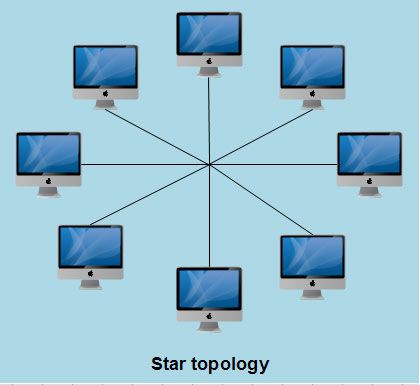The distinguishing feature of star topology is that all nodes are joined at a single point, as shown in Figure. This single point is called as a central node, hub, or switch, to which all other devices are attached directly, generally via UTP or STP. This topology is frequently used for networks in which control of the network is located in the central node. This method is optimal when the bulk of communication is between the central and outlying nodes. If traffic is high between outlying nodes, an undue switching burden is placed on the central node.
Transmission rates vary with AT&T’s Star LAN operating at 1to 10Mbps, and both 100Base-T and 100VG-AnyLAN at 100 Mbps. The primary advantage of a star is that a disruptive or failed station can be isolated; thereby eliminating any negative effect it may have on LAN performance. Additionally, each node has access to the full bandwidth of the LAN, at least in a LAN switch environment. The primary disadvantage is that a hub failure is catastrophic as all connectivity is provided through the central hub, its failure affects the entire LAN.

Example of Star Network
Asynchronous Transmission Mode (ATM)
Asynchronous Transfer Mode (ATM) is an International Telecommunication Union – Telecommunication Standardization Sector (ITU- T) standard for cell relay wherein information for multiple service types, such as voice, video, or data, is conveyed in small, fixed size cells. ATM networks are connection-oriented.
ATM is the emerging standard for communications. It can provide medium to high bandwidth and a virtual dedicated link between ends for the delivery of real-time voice, data and video. Today, in most instances, separate networks are used to carry voice, data and video information mostly because these traffic types have different characteristics. For instance, data traffic tends to be “bursty”. Bursty means that data traffic does not need to communicate for an extended period of time and whenever it needs; it communicates large quantities of information as fast as possible. Voice and video, on the other hand, tend to be more even in the amount of information required but are very sensitive to when and in what order the information arrives. With ATM, separate networks will not be required. ATM is the only standards-based technology that has been designed from the beginning to accommodate the simultaneous transmission of data, voice and video. Using ATM, information to be sent is segmented into fixed length cells, transported to and re-assembled at the destination. The ATM cell has a fixed length of 53 bytes. Being fixed length allows the information to be transported in a predictable manner. This predictability accommodate, different traffic types on the same network. The cell is broken into two main sections, the header and the payload. The payload (48 bytes) is the portion which carries the actual information’, i.e. voice, data, or Video The header (5 bytes) is the addressing mechanism.
 Dinesh Thakur holds an B.C.A, MCDBA, MCSD certifications. Dinesh authors the hugely popular
Dinesh Thakur holds an B.C.A, MCDBA, MCSD certifications. Dinesh authors the hugely popular